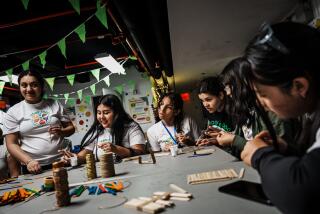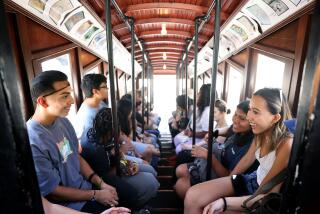Bringing the Inner City to Woodstock : Cultures: Children from a poor, high-crime neighborhood join children who live in a thriving colony of artists, writers, musicians and shopkeepers in the latest chapter of an experiment in diversity.
WOODSTOCK, N.Y. — When the four buses arrived at Woodstock Elementary School on a recent morning, they were greeted by children holding signs decorated with rainbows, peace signs and yin-yang symbols.
“Hola,” called the children.
“Todos los ninos sonrien en la misma lenguaje” declared a banner in the main lobby. “All children smile in the same language.”
Indeed, the radiant smiles on the dark faces pressed against the bus windows--children from New York City’s Washington Heights neighborhood--matched those on the fair ones waiting eagerly outside.
The Woodstock kids and the New York City kids had corresponded, and now they would have a chance to spend the day together, the latest chapter in an ongoing experiment in multicultural learning.
The idea, said Woodstock Principal Ronne Marantz, was to bring together children of different cultures so they can develop an appreciation for the diversity of language, customs, geography and lifestyle, not only on a global scale, but within their own state and nation.
“The spirit of multiculturalism really needs to be done one-on-one with kids,” said Marantz. “It can’t be experienced through textbooks.”
The children are growing up in starkly different environments. The town of Woodstock, snuggled between Overlook and Ohayo mountains in the Catskills, has 6,290 residents along winding roads lined with stone walls and woods. The population is mostly white, middle class.
The school is on the edge of the village of Woodstock, founded as an arts colony in 1902 by English Utopian philosopher Ralph Whitehead. Today it’s still a thriving colony of artists, writers, musicians and shopkeepers.
Salome Urena Middle Academies are in a high-poverty, high-crime inner-city neighborhood 90 miles south of here. But while the neighborhood is poor, the 3-year-old public school offers riches unknown to most schoolchildren.
The 1,350 6th- to 8th-graders at Salome Urena choose among five academies: expressive arts, business, law, community service, and science and mathematics. The Children’s Aid Society is housed within the school, providing extensive services. There are medical and dental clinics.
“Our school is open seven days a week, and until 11 at night,” said Alejandro Soto, a vice principal. “We have a 99% attendance rate.”
Ninety-eight percent of the population around Salome Urena is from the Dominican Republic. “Many of our children are recent arrivals. They’re still struggling with the language,” Soto said.
Last fall, half of the 310 pupils at Woodstock Elementary were matched as pen pals with 150 children from Salome Urena. The children exchanged letters and videos; they agreed to meet at Salome Urena to mark the feast of Santo Domingo in February, and to celebrate Thanksgiving in Woodstock.
Kids bounded off the buses in baggy jeans, sweat shirts and untied sneakers. Many upstate children wore similar garb, but there was also evidence of the recent Woodstock reunion festival with plenty of tie-dyed T-shirts and faded overalls.
Pairs of pen pals gathered on the playground for recess.
“They play basketball better,” said Daniel Curci, 11, of Woodstock. “And they do those clapping games.”
Kadycha Morales, 11, and three friends were doing a complex hand-clapping routine to a Spanish verse.
“My pen pal’s school is beautiful, but small,” Morales said. “She lives in a house, I live in a building. She eats different food. We eat rice, beans, chicken.”
“We’re a lot alike,” said Joey Carey, a fifth-grader in a tie-dyed T-shirt, sitting beside pen pal William Veras. “We both like sports.”
“It’s beautiful here,” said Veras, a soft-spoken, bespectacled 11-year-old. “Nobody curses or kills each other. You can have your own house, with trees. You can have a dog and the landlord won’t bother you.”
Back in their classrooms, the Woodstock students gave talks about the mountains; about boating on the Ashokan reservoir, which supplies drinking water to New York City; and about the early days when nearby Kingston was the state’s first capital.
At the end of the day, the children sat on the linoleum floor of the cafeteria-auditorium, beneath paintings of John Lennon and the Founding Fathers. They listened to a primary grade kazoo band playing Beethoven’s Fifth, and a folk singer warbling peace anthems.
Then they stood with arms around each others’ shoulders, swaying along with a guitar-strumming teacher as they sang “People Are a Rainbow.”
“This is so great,” said Cynthia Kudren, mother of a fifth-grader. “The more kids learn that we’re all just people, the better off we’ll be.”
More to Read
Sign up for Essential California
The most important California stories and recommendations in your inbox every morning.
You may occasionally receive promotional content from the Los Angeles Times.










